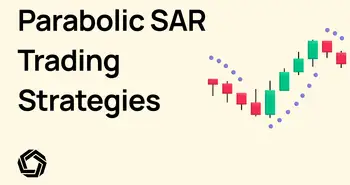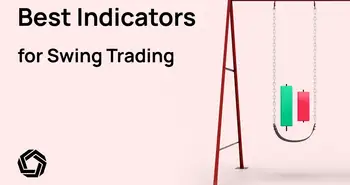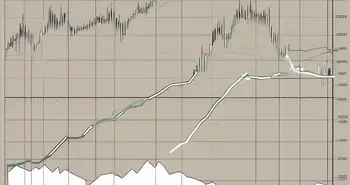Article Contents
Top RSI Trading Strategies: How to Use the Relative Strength Index

Welcome to this article on RSI Trading Strategies, where we will explore the Relative Strength Index and how traders use it for technical analysis. Before we dive in, let's clear the air – RSI has nothing to do with racing and everything to do with trading.
As a technical analysis tool, the Relative Strength Index (RSI) is one of the most widely used indicators by traders around the world. It measures the strength of a stock or market's price action and helps identify overbought and oversold conditions. Knowing when a market is overbought or oversold is critical because it can provide valuable insight into potential market direction and future price movements.
In this article, we will provide an overview of RSI and its mechanics, followed by three real-life trading strategies that traders can use to incorporate RSI into their analysis. By the end of this article, you will have a solid understanding of RSI and be able to apply it to your trading strategy with confidence.
What Is RSI?
Have you ever stumbled across a tweet or an online article that said something like, “The RSI on the chart shows that it's overbought, so we short, and the target should be…”? If you're new to trading, the jargon and technical terms can seem daunting at first, but fear not! We're here to give you an in-depth understanding of RSI so that you can confidently read and interpret it in your trading.
Firstly, let's define what RSI is. The Relative Strength Index (RSI) is a momentum oscillator that measures the speed and change of price movements in a security or market. It oscillates between 0 and 100 and is typically plotted as a line chart below the price chart.
Key Levels to Know
- Above 70: Indicates an overbought condition.
- Below 30: Indicates an oversold condition.
Both levels signal potential price reversals but not necessarily immediate ones.
How to Read RSI in Trading
So, how do we read RSI? Generally, an RSI reading above 70 indicates an overbought condition, while a reading below 30 indicates an oversold condition. An overbought reading suggests that a security has been overbought and could experience a reversal in price, while an oversold reading suggests that a security has been oversold and could experience a rebound in price. It's important to note that overbought or oversold readings don't necessarily mean that a reversal is imminent and that markets can remain in these conditions for prolonged periods.
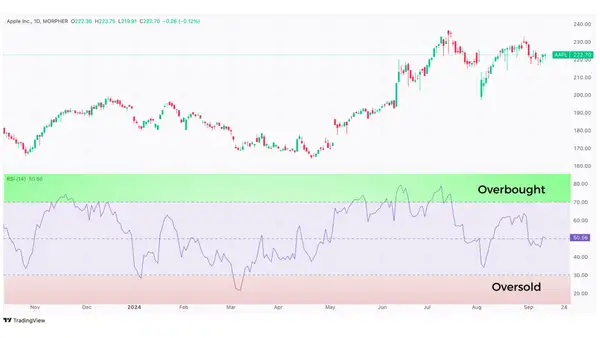
Spotting Divergences Using RSI
One way to use RSI is to look for divergences between the RSI line and the price of the security. When we talk about divergences between the RSI line and the price of a security, we're essentially looking for differences in how the two are moving. If the price of a security is going down, but the RSI line is going up, this is called a bullish divergence. It suggests that even though the price is decreasing, buying pressure is building up, which could lead to a price reversal. Conversely, if the price of a security is going up, but the RSI line is going down, this is called a bearish divergence. It suggests that even though the price is increasing, selling pressure is building up, which could lead to a price correction.
To illustrate this, let's take the example of a stock that has been on an uptrend for a while. As the stock price continues to rise, buyers may become increasingly enthusiastic and start buying the stock even more aggressively, causing the RSI to rise along with the price. However, at some point, the stock may become overbought, which means that it has risen too far, too fast and is due for a correction. When this happens, the buying pressure may wane, even though the stock price is still increasing. As a result, the RSI may start to trend downward even as the price continues to rise, creating a bearish divergence.
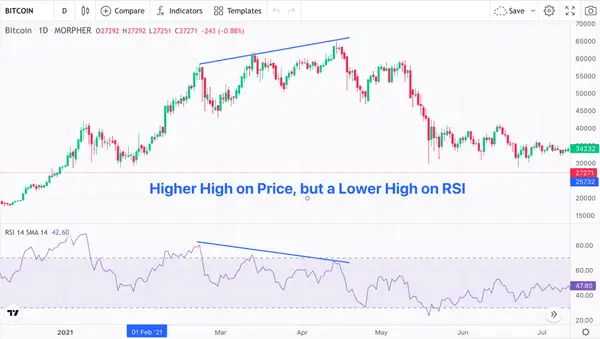
While RSI can be a valuable tool in technical analysis, it's important to note that it's not foolproof. False signals can occur when a security is in a strongly trending market and the RSI is consistently overbought or oversold for an extended period. It's important to use RSI in conjunction with other technical indicators and fundamental analysis when making trading decisions.
So, in which markets is RSI particularly useful? RSI is a versatile indicator that can be used in stocks, commodities, and even cryptocurrencies. However, because RSI is a momentum indicator, it tends to work best in markets that are in a strong trending condition rather than those that are range-bound or choppy.
Top RSI Trading Strategies
Candlestick Patterns and RSI Indicator Strategy
The first strategy we'll cover is a powerful combination of RSI and candlestick patterns that can be applied to any asset class. By using the RSI and identifying the Tweezer Top pattern to confirm an overbought condition, we can make confident trading decisions.
The following strategy is universal and can be applied to any asset class. In this example, we'll use Microstrategy (MSTR) to demonstrate a live scenario in the charts. It's worth noting that the stock is highly correlated with Bitcoin since the company holds a significant amount of Bitcoin on its balance sheet.
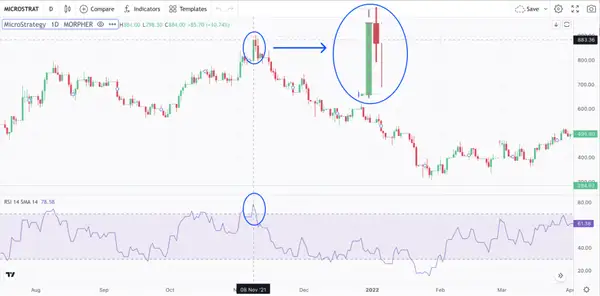
In this case, we're using the RSI to identify overbought patterns, with a reading above 70 indicating that the asset is overbought. The RSI reading for MSTR was around 75, suggesting that the asset was overbought.
The next day, we noticed a potential Tweezer Top pattern forming, which is a reversal pattern that can signal a bearish trend. The pattern was confirmed by the small red real body candle and the overbought RSI value, providing a strong indication that the asset was due for a correction.
A good entry position for a short trade might be around the 700 mark, which could continue until around the 400 mark, where the RSI turns in the opposite direction with a value below 30.
Candlestick Patterns and RSI Trading Rules:
- Look for an overbought RSI (above 70)
- Spot a Candlestick Pattern (Tweezer Top)
- Confirm the pattern with a small red real body candle
- Set a Stop Loss above the Top
- Short the Stock
Using the RSI and the Tweezer Top pattern in conjunction, we can identify potential trading opportunities with higher confidence. However, it's important to note that this strategy should be used in conjunction with other technical analysis tools and with proper risk management in place.
Want to dive deeper into candlestick patterns and unlock more trading strategies? Check out our Ultimate Guide to Candlestick Patterns to enhance your skills and take your trades to the next level with expert insights!
Mean Reversion and RSI Strategy
Mean reversion trading can be profitable when using technical indicators like the RSI to identify overbought and oversold conditions. Mean reversion is based on the assumption that an asset's price will eventually revert back to its mean value after a period of deviation. The RSI is a popular indicator used to identify such conditions. To use the RSI for mean reversion trading, traders look for signals that indicate overbought or oversold conditions. Then, they enter a position in the opposite direction, assuming that the price will eventually revert to its mean value.
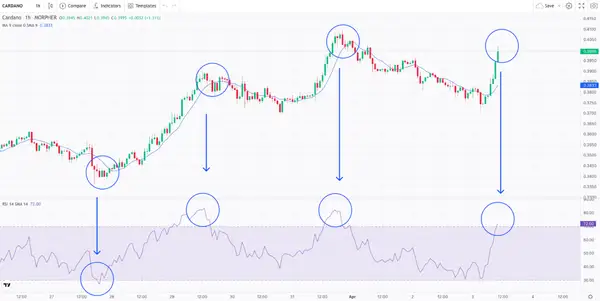
On the Cardano chart, we can see four opportunities where the RSI is showing oversold or overbought indications. At each of these points, the RSI provided a great entry opportunity in terms of a mean reversion strategy.
Once the RSI reaches a value below 30 or above 70, we wait for the mean reversion line to indicate a potential direction change by becoming flatter and entering a position in the opposite direction of the current trend. We exit the position once the price reverts back to the moving average and the RSI is around 50, indicating a neutral market position.
It's important to note that this mean reversion strategy can be used in combination with other technical indicators or fundamental analysis to improve its accuracy and increase the probability of profitable trades.
Mean Reversion and RSI Trading Rules:
- Look for RSI values below 30 or above 70 to identify oversold or overbought conditions respectively.
- Once you have confirmed the reversal signal, enter a position opposite to the current trend.
- Once the price reaches a point around the mean value or shows signs of a trend reversal, look for an RSI value around 50 and exit the position to take profits.
Momentum Strategy Indicators and RSI Strategy
Combining the RSI with other technical indicators like the SuperTrend can help identify potential momentum trading opportunities. The SuperTrend indicator provides entry/exit signals based on the price's relationship with a band calculated using the average true range and a moving average. It is plotted above or below the closing price to signal a buy or sell. When used in combination with the RSI, we can look for overbought or oversold conditions and confirm potential entry/exit signals with the SuperTrend indicator.
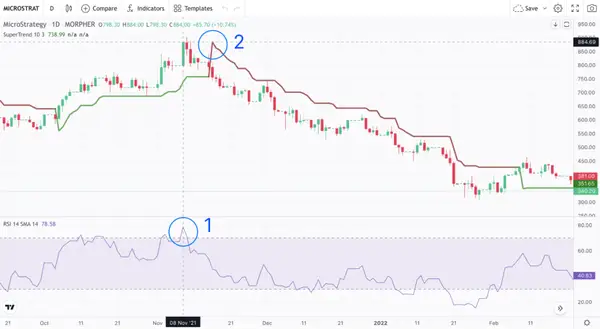
This momentum trading strategy is a universal approach, and traders can experiment with different combinations of indicators to find the best setups for their trading style.
As we analyze the charts, we can see an uptrend in MSTR, with a new top formed on November 8, 2021, followed by a reversal the next day. The RSI indicator confirms that the asset is overbought, suggesting a potential trend reversal. The SuperTrend indicator also confirms the trend reversal, changing color from green to brown.
In the case of MSTR, we identified a good entry position for a short trade at around the 700 mark and the position could have been held until around the 400 mark. It's important to note that the use of leverage in trading can increase both potential profits and potential losses. However, with careful risk management and analysis, combining technical indicators like the RSI and SuperTrend, we had a great confirmation and a profitable trading opportunity. In the case of MSTR, this trading strategy could have resulted in significant profits, especially if leverage was used.
Momentum Strategy Indicators and RSI Trading Rules:
- Look for potential trend reversals using the RSI indicator when the reading is above 70 or below 30.
- Confirm the trend reversal with the SuperTrend indicator changing colors and signaling a buy or sell entry point.
- Enter a short position when the SuperTrend indicator turns brown and the RSI indicates overbought conditions.
- Exit the position when the SuperTrend indicator changes colors and signals an opposite entry point or when the RSI approaches 30.
- Use proper risk management techniques to manage potential losses and maximize profits, including stop-loss orders and position sizing.
With these rules in mind, the RSI and SuperTrend strategy can be used to capture potential gains in a momentum trading strategy. By combining the RSI with other indicators, such as the SuperTrend, traders can have a more comprehensive understanding of the market conditions and make more informed trading decisions.
Conclusion
If you’re looking to sharpen your trading strategies, the RSI indicator on Morpher could be your key to success. With our zero-fee platform, you can easily integrate RSI into your trades, combining it with candlestick patterns, mean reversion, momentum strategies, and more. Detect overbought and oversold conditions, identify trend reversals, and seize market opportunities—all with Morpher’s seamless and innovative trading experience. Take your trading to the next level with RSI on Morpher. Sign up now!

Disclaimer: All investments involve risk, and the past performance of a security, industry, sector, market, financial product, trading strategy, or individual’s trading does not guarantee future results or returns. Investors are fully responsible for any investment decisions they make. Such decisions should be based solely on an evaluation of their financial circumstances, investment objectives, risk tolerance, and liquidity needs. This post does not constitute investment advice.

Painless trading for everyone
Hundreds of markets all in one place - Apple, Bitcoin, Gold, Watches, NFTs, Sneakers and so much more.

Painless trading for everyone
Hundreds of markets all in one place - Apple, Bitcoin, Gold, Watches, NFTs, Sneakers and so much more.



